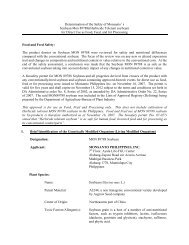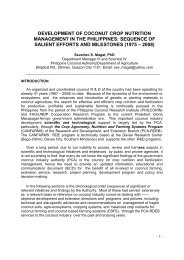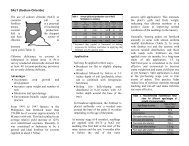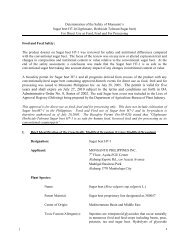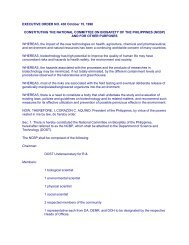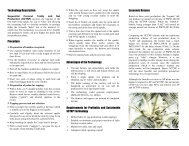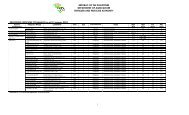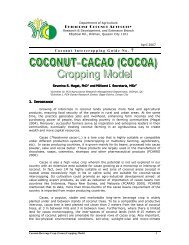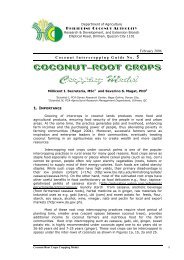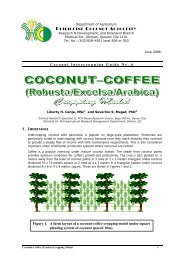2009 Annual Reports - Bureau of Fisheries and Aquatic Resources
2009 Annual Reports - Bureau of Fisheries and Aquatic Resources
2009 Annual Reports - Bureau of Fisheries and Aquatic Resources
You also want an ePaper? Increase the reach of your titles
YUMPU automatically turns print PDFs into web optimized ePapers that Google loves.
ANNUAL REPORT <strong>2009</strong>Adora Gamido briefs visitors including Isabela AssistantProvincial Agriculturist / Provincial Fishery Officer LynfaAquino during the harvest field day September 8, <strong>2009</strong>.Only 18 bags <strong>of</strong> commercial fish feeds wereconsumed in the demo due to the use <strong>of</strong> duckweeds<strong>and</strong> the application <strong>of</strong> 45-days delayed feedingstrategy. This is significantly lower than current rule<strong>of</strong> thumb among fish farmers which is 8 to 10 bagsfeeds, per thous<strong>and</strong> pieces <strong>of</strong> stock.Reduction on feed cost translates to a netincome <strong>of</strong> P 25,313.00 at 62 pesos farm gate price.Production cost is 20,567 .00 pesos.According to Victoriano Gamido, projectcooperator in Alicia, it was his first time to cut onfeed expenses <strong>and</strong> still has a nice return. The use <strong>of</strong>duckweeds significantly cushions impact <strong>of</strong> currentcrisis, he said.The cooperator also said that duckweed isa good alternate for commercial feeds especially forsmall farmers who <strong>of</strong>tentimes, are short on capital.What are duckweedsThe natural habitat <strong>of</strong> duckweeds is thesurface <strong>of</strong> fresh or brackish water that is shelteredfrom wind <strong>and</strong> wave action. They are found in all butwaterless deserts or permanently frozen areas <strong>and</strong>grow best in tropical <strong>and</strong> temperate zones.According to Romeo Pizarro, farm manager<strong>of</strong> APCFF <strong>and</strong> project leader on duckweeds, theplant prefer partly shaded area <strong>and</strong> grows luxuriantlyduring the rainy months.Moreover, fertilization is needed in order toincrease the protein content <strong>of</strong> the plant. Pizarro saysthat normal fertilization in the fishpond is enoughwhen culturing duckweeds alongside fish.How to plant duckweedsPlanting duckweeds simply entail puttingpropagules (fresh duckweeds) in the culture mediumwhich can be in concrete tanks, empty ponds or innet enclosure set in fishponds itself.Duckweeds reproduction is primarilyvegetative. It can double its mass within 2 daysfrom time <strong>of</strong> planting. It is necessary though, to havemultiple production areas <strong>and</strong> to plant on staggeredbasis as duckweeds have senescence (die-<strong>of</strong>f) period<strong>of</strong> around 30 days.BFAR RO2 recommends use <strong>of</strong> 10% <strong>of</strong> totalfishpond area for duckweed production to be sure.Main pest on duckweed culture, Pizarro said,are kuhol <strong>and</strong> case worm from butterflies.Duckweeds as feed supplementLiterature cites crude protein (CP) content<strong>of</strong> fresh duckweeds <strong>of</strong> up to 43%. Dry samplessubmitted by BFAR RO2 for analysis however yielded18.4% only.Duckweeds is fed fresh <strong>and</strong> since it floats,it may be totally used by fish. Pizarro, however,underscored the need to stock size 14 fingerlingsto enable the fish to immediately ‘eat’ or ‘swallow’the plant.Other potential uses <strong>of</strong> duckweedsReferred to as “egg from the water”, theBurmese, Laotians <strong>and</strong> Thai have long used the plantas vegetable, according to literature.The plant can reduce algae growth (excessivegrowth <strong>and</strong> its die-<strong>of</strong>f consumes dissolved oxygen<strong>and</strong> can result to fish kill), coliform bacterial counts<strong>and</strong> mosquito larvae on ponds. Through the process<strong>of</strong> photo synthesis, duckweeds can thus aid incombating global warming.Individuals who were lucky to sample tilapiaproduced from the demo in Gamido’s farm said thatits taste is superior to those that are raised using purecommercial feeds. This confirms earlier taste sensoryevaluation conducted by APCFF.Fish farmers who are short on capital cannow engage in the highly lucrative tilapia farmingbusiness by using duckweeds as supplementalfeeds. Currently, the bureau is undertaking full-scaleproduction <strong>and</strong> distribution <strong>of</strong> duckweeds at APCFF.15



